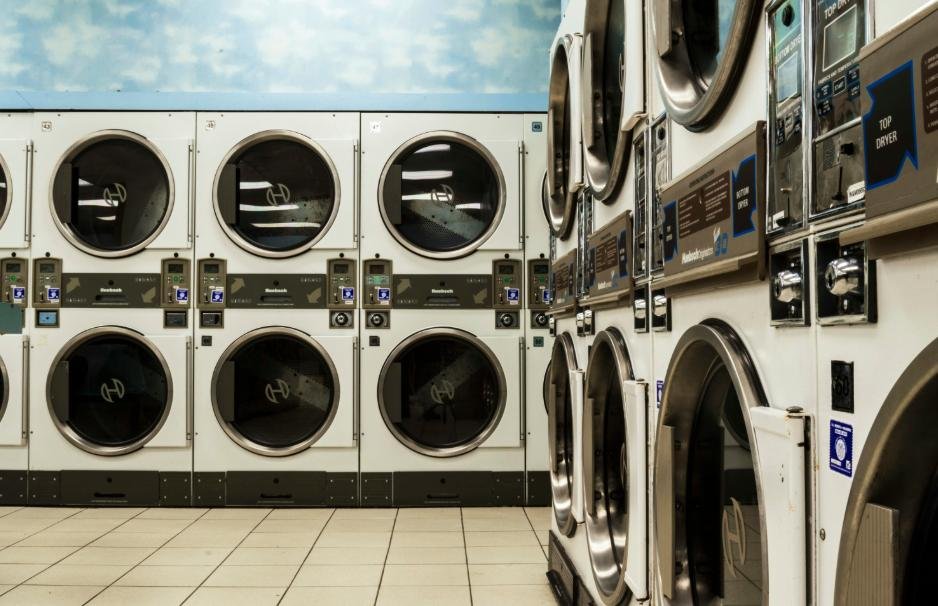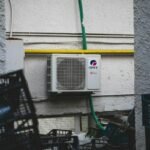Understanding Vented Tumble Dryers
A vented tumble dryer is a popular type of drying appliance designed to remove moisture from wet laundry. The mechanism of a vented dryer operates by drawing in air from the surrounding environment, heating it, and then circulating it through the drum where the damp clothes are located. As the hot air travels through the clothes, it absorbs moisture, which is subsequently expelled outside through a venting hose. This process allows for effective drying; however, it is essential to ensure that the vent is correctly installed to prevent recirculation of the moist air.
In contrast to vented tumble dryers, there are two other common types: condenser and heat pump dryers. A condenser dryer uses a closed-loop system where the humidity is condensed back into water and collected in a tank, eliminating the need for external venting. A heat pump dryer operates similarly but employs a more energy-efficient system that reuses the hot air, significantly reducing energy consumption. The main difference between these systems lies in their installation requirements and operational efficiencies.
Vented tumble dryers offer several benefits, including quicker drying times and generally lower purchase costs than their condenser and heat pump counterparts. Furthermore, they can be particularly effective in environments with lower humidity levels. However, the primary drawbacks include the necessity for a designated venting area and a potential increase in energy usage, especially in colder climates where the efficiency can diminish. Additionally, there is a possibility of lint build-up in the vent, which can influence the longevity of the appliance and pose a fire risk if not regularly maintained. Thus, while vented dryers can be an effective solution for many households, understanding their operational characteristics is crucial when considering the best dryer for your needs.
Assessing Your Laundry Needs
When selecting the best vented tumble dryer for your home, it is essential to begin by evaluating your laundry needs. One of the primary factors to consider is the size of your household. A larger family typically generates more laundry, which necessitates a dryer with a greater capacity. Identifying the amount of laundry you produce per week will help in choosing a dryer that can efficiently accommodate your needs, potentially reducing drying times and energy consumption.
Frequency of laundry is another important aspect to consider. If you find yourself doing laundry multiple times a week, a high-capacity vented tumble dryer is advisable, as it can handle larger loads effectively. Conversely, if laundry days are infrequent, a smaller model may suffice, allowing you to save on both initial and ongoing costs. Understanding your personal routine will assist you in determining which dryer model is most suitable for your lifestyle.
In addition to household size and laundry frequency, the types of fabrics you typically wash should also influence your decision. Different fabrics have varying drying requirements; for instance, delicate items might necessitate a gentler drying process compared to thicker fabrics such as towels or bedding. Advanced dryers often come with specialized settings that cater to different materials, ensuring optimal performance and care for your garments.
Finally, the drying capacity of the tumble dryer is a pivotal consideration. Ensuring the dryer can accommodate your average laundry load is crucial. It is advisable to check the manufacturer’s specifications and compare them to your typical laundry volume. By thoroughly assessing these elements, you will be well-equipped to choose a vented tumble dryer that aligns with your laundry habits and requirements, resulting in an efficient and practical investment for your household.
Energy Efficiency and Cost Considerations
When selecting a vented tumble dryer, energy efficiency is a crucial factor that can significantly impact both the operational costs and environmental footprint of the appliance. Modern vented tumble dryers are assigned energy efficiency ratings ranging from A+++ to D, with A+++ models being the most efficient. Understanding these ratings is essential for making an informed purchase that aligns with your budget and sustainability goals.
To interpret the energy label, look specifically at the annual energy consumption figure, usually expressed in kilowatt-hours (kWh). This figure allows consumers to gauge the approximate running costs of the appliance. Energy-efficient models may have a higher initial purchase price but can lead to substantial long-term savings on electricity bills. For example, while a lower-rated model may cost $400 initially, a higher-rated unit priced at $600 might save you a significant amount in energy costs over the years.
Additionally, consumers should consider the appliance’s drying performance in conjunction with its energy efficiency. An energy-efficient tumble dryer should not only consume less power but also effectively dry clothes in a shorter time frame. This efficiency can lead to reduced wear and tear on garments, ultimately extending their lifespan. Many leading brands now combine both high performance and energy efficiency, ensuring that consumers do not have to sacrifice one for the other.
Furthermore, it is advisable to compare running costs across different models by calculating the estimated annual energy consumption based on your frequency of use. Online energy calculators can assist in projecting these costs accurately. Ultimately, investing in an energy-efficient vented tumble dryer will not only save you money but also contribute positively to environmental conservation efforts. Thus, careful consideration of energy ratings, costs, and potential savings will lead to a more informed purchasing decision.
Key Features to Look For
When selecting a vented tumble dryer, it is crucial to consider various defining features that significantly influence usability and performance. One of the primary aspects to explore is the range of drying programs available. A dryer equipped with multiple programs allows users to optimize drying cycles for different fabric types, ensuring efficient care of garments. These options include settings for cottons, synthetics, and delicates, each tailored to handle specific textiles effectively.
Another important feature to look for is sensor drying technology. This advanced functionality monitors the moisture levels within the drum and automatically adjusts the drying time accordingly. By preventing over-drying, sensor drying not only enhances energy efficiency but also prolongs the lifespan of clothes, maintaining their quality over time.
Additionally, reverse action tumbling is a feature worth considering. This innovative mechanism alternates the direction of the drum during the drying cycle. Such an operation helps to reduce tangling and creasing of clothes, resulting in a more even drying process and less time spent on ironing after laundry is completed.
Furthermore, you may want to evaluate the additional functionalities that some vented tumble dryers offer. Features such as a delay start option, which permits users to schedule drying cycles conveniently, and a lint filter indicator, which alerts when cleaning is required, can enhance user experience significantly. Energy ratings are another essential consideration; selecting an energy-efficient model can lead to savings on electricity bills and environmental benefits over its usage lifetime.
By assessing these key features, including various drying programs, sensor technology, reverse action tumbling, and other functionalities, potential buyers can make informed decisions that align with their specific laundry needs and preferences.
Space and Installation Requirements
When selecting a vented tumble dryer, it is crucial to consider the space and installation requirements to ensure optimal performance and convenience. First and foremost, adequate space must be allocated for the dryer, which typically requires a width of about 60 centimeters and a depth of approximately 60 centimeters. Notably, sufficient clearance should be provided around the unit to facilitate airflow and maintenance. Ideally, a minimum of 10 centimeters of space on each side and a few centimeters at the back may be recommended to accommodate the dryer’s exhaust system effectively.
Ventilation options are another vital aspect of the installation process. Vented tumble dryers expel humidity-laden air outside through a venting hose, making it essential to install the dryer near an exterior wall or a window where the exhaust can be expelled efficiently. An ideal location would provide a straight path for the vent hose, thereby minimizing bends that could restrict airflow and decrease dryer efficiency. In environments where exterior access is limited, alternative ventilation systems, such as using ducting kits, may be considered to ensure proper air circulation.
Furthermore, the importance of proper ducting cannot be overstated. Using rigid ducting instead of flexible plastic options is advisable, as it minimizes airflow restrictions and reduces the risk of lint buildup, which can pose a fire hazard. Ensure the ducting is securely connected, airtight, and as short as possible to promote efficient air expulsion. Regular maintenance, including cleaning the vent and ducting system, is essential to prevent blockages and ensure the dryer operates at peak efficiency. By adhering to these space and installation guidelines, users can maximize the performance and reliability of their vented tumble dryers.
Brand Comparisons and Recommendations
When selecting a vented tumble dryer, the brand plays a crucial role in determining the quality, performance, and longevity of the appliance. Understanding the strengths and weaknesses of popular vented tumble dryer brands can greatly aid consumers in making an informed decision tailored to their specific needs. Key brands in the market include Bosch, Hotpoint, and Beko, each with unique features and customer feedback.
Bosch is renowned for its reliability and energy efficiency, boasting a clean design and advanced drying technology. Many users appreciate the quiet operation of Bosch models, making them suitable for homes where noise is a concern. However, the price point can be higher than other brands, which may deter budget-conscious shoppers.
Hotpoint, on the other hand, offers an appealing range of mid-range pricing options, providing solid performance without breaking the bank. It is recognized for its user-friendly interfaces and efficiency. Customers have reported satisfactory results in moisture removal and rapid drying cycles. Nonetheless, some users have pointed out concerns regarding the longevity of certain models, indicating a potential need for more regular maintenance.
Beko stands out for its affordability and practicality, often catering to families or individuals seeking budget-friendly options. The brand incorporates various innovative features, such as moisture sensors and a reverse tumble action that minimizes creasing. While Beko dryers might not have the same premium efficiency as Bosch, they still receive positive feedback for their functionality. However, prospective buyers should consider that customer service experiences vary among different retailers.
In conclusion, when diving into the world of vented tumble dryers, understanding brand differences can be immensely beneficial. By assessing customer reviews and expert ratings, consumers can allocate their resources efficiently and select a product best suited to their drying needs.
Budgeting for Your Purchase
When planning to purchase a vented tumble dryer, carefully considering your budget is a critical step to ensure satisfaction with your investment. Vented tumble dryers typically fall within a price range from approximately $300 to $1,200, depending on the features and brand. Entry-level models often offer basic functions, making them suitable for those on a tighter budget, while higher-end options provide advanced features such as moisture sensors, multiple drying programs, and enhanced energy efficiency.
When assessing your budget, it is essential to weigh your immediate financial constraints against your long-term needs. A more premium model may require an initial investment that could seem daunting, but its durability and energy efficiency can lead to lower operating costs and fewer replacements in the long run. Furthermore, investing in quality appliances can save you money on repairs and replacements, which adds value to your purchase.
In terms of financing options, many retailers offer payment plans or financing through third-party services, allowing consumers to spread out the cost of their purchase over time. This method can alleviate the pressure of budgeting for a vented tumble dryer, permitting buyers to select a model that best meets their functional and longevity expectations without being solely limited to their immediate cash availability.
It is also important to read consumer reviews and compare mid-range and premium models. Mid-range dryers generally offer a balance between cost and functionality, whereas premium models often come equipped with additional features that cater to specific user needs. Understanding your priorities and what features are most beneficial for your household will greatly aid in making an informed decision. In doing so, your purchasing experience is likely to be both satisfying and economical, leading to a smart investment that stands the test of time.
Maintenance Tips for Longevity
Maintaining your vented tumble dryer is crucial to ensure its efficient operation and longevity. One of the primary maintenance practices involves routine cleaning, which should be performed regularly to avoid lint buildup. Lint can obstruct airflow and significantly reduce the performance of the dryer, potentially causing overheating or even fire hazards. It is recommended to clean the lint filter after every use to keep the appliance running smoothly. Additionally, periodically check the venting duct for any blockages or accumulations of lint, as these can hinder the dryer’s efficacy.
Another essential maintenance aspect includes inspections of the vent hose and connections. Make sure that these are securely attached and without kinks or damage. If any signs of wear or blockages are detected, replace or clean the venting system immediately. It is advisable to detach the hose from the dryer and clean it thoroughly at least once every six months. This practice helps maintain optimal airflow, ensuring that your vented tumble dryer dries clothes efficiently.
Furthermore, the drying drum should be cleaned occasionally to remove any residue or detergent buildup. A damp cloth can be used to wipe the inner surfaces. Be cautious not to use abrasive cleaners that might scratch or damage the drum’s surface. Regularly checking the machine for any unusual sounds or malfunctions can help catch minor issues before they escalate into larger problems. Should you encounter persistent issues, it is wise to consult the manufacturer’s guidelines or contact a professional technician for assistance to avoid compromising your dryer’s performance.
By adhering to these maintenance tips, you can significantly enhance the lifespan of your vented tumble dryer, ensuring that it continues to operate efficiently for years to come.
Conclusion and Final Recommendations
Choosing the best vented tumble dryer involves careful consideration of various factors tailored to individual needs and preferences. Throughout this guide, we have highlighted essential aspects, including the drying capacity, energy efficiency, and features specific to vented models. These elements play a vital role in ensuring that you select a dryer that not only meets your laundry demands but also aligns with your lifestyle and budget.
Firstly, understanding the capacity of the dryer relative to your household size is crucial. Selecting a model that can handle your typical laundry volume will reduce drying cycles and associated energy costs. Additionally, the energy efficiency rating of a tumble dryer is pivotal. Opting for a model with a higher rating not only contributes to environmental sustainability but also minimizes long-term expenses related to energy consumption.
Furthermore, consider the additional features that enhance usability, such as sensor drying, which prevents over-drying and fabric damage. User-friendly controls and programmable settings can significantly enhance your drying experience, making it more convenient. Ultimately, your decision should take into account the specific features that are most beneficial for your routine and fabrics.
Lastly, it is essential to reflect on your space limitations, including appropriate installation areas and venting requirements, to avoid any potential complications. By analyzing these critical elements thoroughly, you will be better equipped to make a well-informed choice that meets your specific circumstances.
In conclusion, selecting the best vented tumble dryer is a balanced process of evaluating your personal needs while considering the essential features available. Taking the time to weigh your options carefully ensures that you invest in a reliable appliance that delivers effective performance for your household efficiently.


